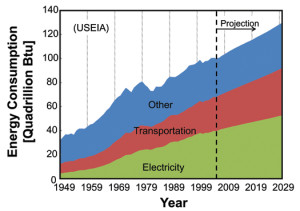Energy consumption: did you know that …
Originally published on Facts Random
 Only 10% of energy in a light bulb is used to create light. Ninety percent of a light bulb’s energy creates heat. Compact fluorescent light bulbs (CFLs), on the other hand, use about 80% less electricity than conventional bulbs and last up to 12 times as long.g
Only 10% of energy in a light bulb is used to create light. Ninety percent of a light bulb’s energy creates heat. Compact fluorescent light bulbs (CFLs), on the other hand, use about 80% less electricity than conventional bulbs and last up to 12 times as long.g- Refrigerators in the U.S. consume about the same energy as 25 large power plants produce each year.e
- There are two basic groups of energy: renewable energy and nonrenewable. Three quarters of the world’s energy is generated by burning fossil fuels.h
- Enough sunlight reaches the earth’s surface each minute to satisfy the world’s energy demands—for an entire year.d
- The amount of energy Americans use doubles every 20 years.g
 From 2008 to 2030, world energy consumption is expected to increase more than 55%.g
From 2008 to 2030, world energy consumption is expected to increase more than 55%.g- About 5,000 years ago, the energy people consumed for their survival averaged about 12,000 kilocalories per person each day. In AD 1400, each person was consuming about twice as much energy (26,000 kilocalories). After the Industrial Revolution, the demand almost tripled to an average of 77,000 kilocalories per person in 1875. By 1975, it had tripled again to 230,000 kilocalories per person.c
- The world’s biggest blackout occurred on August 14, 2004, when a massive power outage occurred across the northeastern U.S. and throughout Ontario, Canada, affecting 50 million people.g
 Google accounts for roughly 0.013% of the world’s energy use. It uses enough energy to continuously power 200,000 homes.a
Google accounts for roughly 0.013% of the world’s energy use. It uses enough energy to continuously power 200,000 homes.a- According to Google, the energy it takes to conduct 100 searches on its site is equivalent to a 60-watt light bulb burning for 28 minutes. Google uses about 0.0003 kWh of energy to answer the avenge search query, which translates into about 0.2 g of carbon dioxide released.a
- The United States produces half of its electricity from coal. China uses coal to generate more than ¾ of its electricity. Australia, Poland, and South Africa produce an even greater percentage. Overall, coal makes up 2/5 of the world’s electricity generation.e
- Ten countries produce 2/3 of the world’s oil and hold the same percentage of known reserves. Saudi Arabia tops both lists.e
- Ten countries produce 2/3 of the world’s natural gas and hold about the same percentage of known reserves.e
- The United States produces more nuclear-generated electricity than any other country, nearly 1/3 of the world’s total. The second largest producer is France, which generates more than 3/4 of its electricity in nuclear reactors.f
 The most powerful hydroelectric project in the world is China’s Three Gorges Dam. The controversial and enormous power plant brings power to millions of Chinese villagers and will generate more than 22,000 megawatts from six generators.d
The most powerful hydroelectric project in the world is China’s Three Gorges Dam. The controversial and enormous power plant brings power to millions of Chinese villagers and will generate more than 22,000 megawatts from six generators.d- In 2007, wind produced 1.3% of the electricity in the world. The world’s largest wind farm is the Horse Hollow Wind Energy Center near Abilene, Texas. Covering 92 square miles, the center has more than 400 turbines that are 262 feet tall. They produce 735 megawatts of electricity.d
- Approximately 30% of energy used in buildings is used inefficiently or unnecessarily.h
- Over 86% of the energy used in the U.S. each year is from the combustion of fossil fuels.h
- Some researchers suggest that if developers had to prepay 50 years’ worth of utility bills, they would construct buildings differently.h
- Cooling and heating costs make up approximately 1/2 of an average U.S. home’s total energy bill.h
- On average, one pool pump consumes electricity equal to 44% of the annual electricity consumption of a typical California household. There are over 7 million pools in America.h
- In the last 50 years, atmospheric CO2 has shot up to levels unprecedented in the previous 400,000 years. The man-made injection of CO2 into the atmosphere is primarily from the burning of fossil fuels.h
- American hospitals are some of the most energy-intense buildings on the planet.h
- Electric utilities are the largest source of greenhouse gas in America.h
- In 2008, the Wall Street Journal reported that transportation fuel consumption in the U.S. would grow from 150 billion gallons annually in 2020 to over 250 billion gallons by the middle of this century. Researchers hypothesize that we would have to export trillions of dollars to oil producing countries, which would compromise our currency, our economy, and our environment.h
- Lighting currently accounts for about 20% of U.S. electricity consumption.h

- James Hansen, director of NASA’s Goddard Institute for Space Studies, has argued, “Coal is the single greatest threat to civilization and all life on our planet.” In America, burning coal releases more CO2 in the air than all cars and trucks combined.h
- In the average home, 75% of the electricity used to power home electronics is consumed while the products are turned off. The average desktop computer idles at 80 watts, while the average laptop idles at 20 watts. A Sony PlayStation 3 uses about 200 watts and nearly as much when idle. Idle power consumes more electricity than all the solar panels in America combined.h
- On a hot summer afternoon, California consumes the entire output of two large nuclear reactors pumping water.h
- One ceiling fixture can use $2,000 to $5,000 of electricity over its useful life.h
- The most energy-intensive part of the food chain is the kitchen. Much more energy is used to refrigerate and prepare food in the home than is used to produce it in the first place.h
- China has taken over the U.S. as both the world’s largest CO2 emitter and the world’s largest energy consumer.e
- Heating and cooling rooms use the most energy in American homes today.e
- Civilization’s first significant energy invention was fire. It was only about 5,000 years ago that humans began using other energy sources such as wind. In America, the first natural gas light was created in 1821. The first oil well was dug in 1859. The first gasoline car was built in 1892.c
 Thomas Edison built the first power plant, and in 1882 his Pearl Street Power Station sent electricity to 85 buildings. People were initially afraid of electricity and parents would not let their children near the lights.c
Thomas Edison built the first power plant, and in 1882 his Pearl Street Power Station sent electricity to 85 buildings. People were initially afraid of electricity and parents would not let their children near the lights.c- English polymath Thomas Young (1773-1829) was the first to use the word “energy” in its current sense, replacing the traditional term vis viva, meaning “living force.”c
- In the United States, petroleum provides the most energy, more than coal, natural gas, or solar energy.e
- Hydropower is the main renewable energy source the U.S. relies on—more than wind, solar, or geothermal power.g
- Coal generates more electricity than any other source. It produces twice as much electricity as natural gas.e
- America burns nearly half of the world’s gasoline.e
 More than 1/5 of the world’s primary energy is used for transport, followed by industry, construction, and agricultures. Much is in the form of gasoline, of which nearly 792.5 million gallons is burned every day.e
More than 1/5 of the world’s primary energy is used for transport, followed by industry, construction, and agricultures. Much is in the form of gasoline, of which nearly 792.5 million gallons is burned every day.e- The top seven oil consumers combined use more than half of the world’s total. The United States alone uses more than a quarter.e
- A “watt” is a unit of power that measures the rate of producing or using energy. The term was named after Scottish engineer James Watt (1736-1819), who developed an improved steam engine. Watt measured his engine’s performance in horsepower. One horsepower equaled 746 watts.e
- Just 1/3 of the energy in burning coal reaches the consumer as electricity.e
- Researches note that energy is the key “to the advancement of civilization” and that energy is the catalyst that allows human societies to evolve.d
- The word “energy” comes from the Greek energeia, meaning operation, activity.d
- Energy cannot be destroyed or created—only transformed.c
- Albert Einstein defined energy as mass multiplied by the speed of light squared, or e=mc2.c
- Food contains energy, which is measured in calories or joules.c
- According to the World Fact Book 2008, the world’s oil reserves will last until 2052 and gas reserves will last until 2065.e
- The World Coal Institute says that, at current production levels, proven coal reserves are estimated to last 147 years. That means no more coal after 2155.e
- More than 1/3 of the world’s crude oil is refined into gasoline. Other main products are distillate fuel oil (mainly diesel oil) and jet fuel (mainly kerosene).e
- Inefficient appliances, drafty windows and doors, poor insulation, and other fixable energy wasters cost U.S. consu
 mers an estimated $300 billion a year—more than the U.S. military budget.e
mers an estimated $300 billion a year—more than the U.S. military budget.e - If a person yelled for 8 years, 7 months, and 6 days, he or she would produce enough energy to heat one cup of coffee.e
- A hurricane releases 50 trillion to 200 trillion watts of heat energy. This is as much energy as a 10-megaton nuclear bomb exploding every 20 minutes.b
Countries with World’s Most Oil Reserves e
Countries with World’s Most Natural Gas Reserves e
Countries with World’s Most Coal Reserves e
Countries with World’s Highest Oil Production d
Countries with World’s Highest Oil & Total Fuel Consumption d
Energy Use of Common Household Appliances g
Projected Increase in World Energy Consumption between 2005 and 2030 g
Sources of Energy g
|
References
a Albanesius, Chloe. “How Much Electricity Does Google Consume Each Year?” PC Mag. September 8, 2011. Accessed: February 8, 2012.
b “Answers Archive: Attempts to Weaken, Destroy Hurricanes.” USA Today. Various dates. Accessed: February 8, 2012.
c Eberhart, Mark E. 2007. Feeding the Fire: The Lost History and Uncertain Future of Mankind’s Energy Addiction. New York, NY: Harmony Books.
d Morris, Neil. 2010. The Energy Mix. Mankato, MN: Smart Apple Media.
e —-. 2010. Fossil Fuels. Mankato, MN: Smart Apple Media.
f —-. 2010. Nuclear Power. Mankato, MN: Smart Apple Media.
g Royston, Angela. 2009. Sustainable Energy. Mankato, MN: Arcturus Publishing Limited.
h Sherwin, Elton B. 2010. Addiction to Energy: A Venture Capitalist’s Perspective on How to Save Our Economy and Our Climate. Knoxville, TN: Energy House Publishing.

